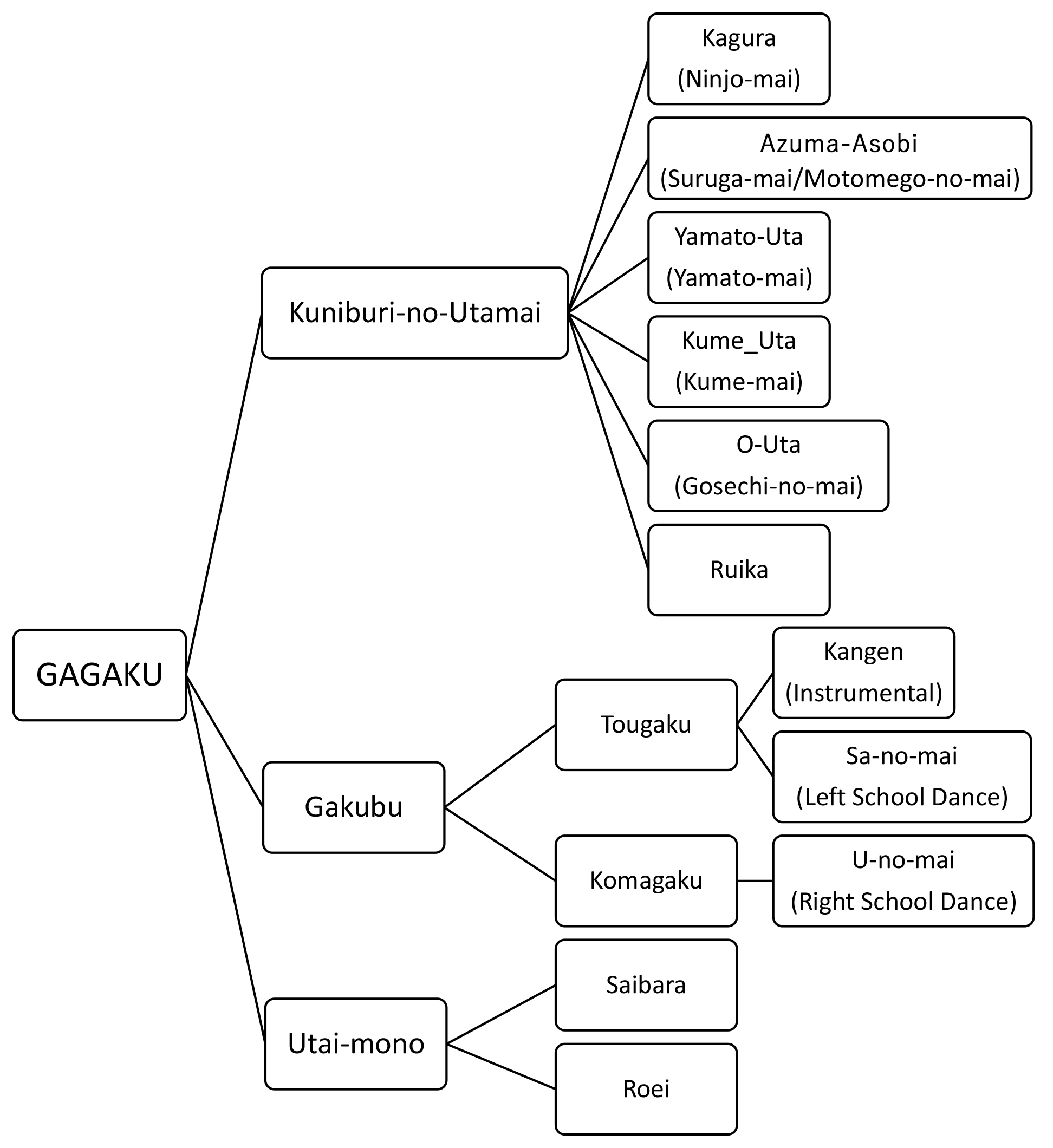The term Gagaku literally means elegant music, but it also refers to classical music as well.
It is now used in Japan as the generic name for the most ancient form of Japanese music. This music was perfected, for the most part, in the 10th century on the basis on, or under the influence of, the music of the ancient countries of the Asian Continent. It was performed mainly at the Imperial court, in aristocratic society, and at important shrines and temples.
There are many styles and genres in Gagaku, but all of them, with a tradition of over a thousand years, have a precious historical value as the oldest form of musical culture existing in the world today.

Gagaku is divided into three categories, according to the roots or places of origin of each style.
"Kuniburi-no-Utamai" (native-style songs and dances)
These songs developed into their present form in the 10th century. They are based on the primitive songs of ancient Japan such as "Kagura", "Azuma-Asobi", "Yamato-Uta", "Kume-Uta", "O-Uta", and "Ruika". They improved under the influence of the music and dances of the Asian Continent.
"Gakubu of Continental Origin" (continental music and dances)
These styles of instrumental music and dances, which have been introduced to Japan, are based on those of China, Korea and other countries of the Asian Continent, they came to be classified, according to their origin, into music and dances of the Left School and those of the Right School, which differ from each other in the arrangement of the instruments. The music and dances of the Left School, based on those originating in China, Central Asia and India, are called "Togaku" (Chinese music). The music and dances of the Right School, mainly based on those originating in Korea and Manchuria (northern China), are known as "Komagaku" (Korean music).
"Utai-mono" (vocal, or recitative pieces)
This is vocal music, composed under the influence of the continental music during the Heian Period (794 -1192) and sung with the accompaniment of Chinese instruments.
They comprise the "Saibara" whose lyrics come from Japanese folk songs and "Roei" (recitation) whose words.
Gagaku is divided into three forms according to the manner of performance.
“Kangen” (winds & strings)
“Kangen” is performed solely with instruments, namely, three kinds of wind instruments such as “Sho", "Hichiriki" and "Ryuteki" , two kinds of string instruments such as “Biwa" and “So", and three kinds of percussion instruments such as “Kakko", "Taiko" and “Shoko”. In “Kangen”, the wind instruments play the main part; that is, "Hichiriki” plays the theme,"Ryuteki” plays the same, but somewhat ornamentally and “Sho” provides the chords. The string instruments are mostly used for rhythm, as are also the percussion instruments. In this form of performance, the instruments are played slowly and delicately, contrary to the next form,"Bugaku",in which they are played vigorously.
“Bugaku” (dance)
In this form of Gagaku, dances are performed to the accompaniment of music. The dances are divided into three kinds; namely “Sa no-Mai” accompanied by “Togaku”, "U-no Mai” accompanied generally by “Komagaku” and "Kuniburi-no Mai” (native-style dances) accompanied by songs.
In “Sa no-Mai”, the Left-School dances, costumes of red or similar colors are used as a rule. Wind and percussion instruments play the accompaniment, and as a rule, string instruments are not used. The dancers dance to the rhythm of the percussion instruments.
In “U-no Mai” ,the Right-School dances, costumes of green or similar colors are used as a rule. Wind and percussion instruments play the accompaniment, and string instruments are never used. The dancers dance to the rhythm of the percussion instruments.
“Kuniburi-no Mai” (native-style dances) is elegant and dignified, though the costumes and dances are both plain and simple. Japanese instruments and those of foreign origin accompany the songs.
“Kayo” (vocal)
“Kayo” includes “Kuniburi-no Uta”,“Saibara”, and “Roei”. Instruments of foreign origin such as “Hichiriki”, “Ryuteki", and “Komabue” and Japanese instruments such as “Wagon” and “Kagurabue” accompany “Kuniburi-no Uta “(native-style songs). “Sho” is never used. They are sung in an unhurried and graceful manner to the beating of time by “Shaku-Byoshi”.
“Saibara” is a form of singing accompanied by three wind and two string instruments. The songs are popular Japanese
folk songs and are sung rhythmically to the beating of time by “Shaku-Byoshi”.
In “Roei” (recitation ), the accompaniment is played by the three wind instruments only, and elegant Chinese poems are recited using Japanese pronunciation without rhythm.
In all these forms of “Kayo” (vocal music), the songs are sung solo at the outset of the stanza and thereafter in unison by all members of the chorus. The wind instruments are each played by the principal players alone. “Sho” keeps the time in the case of singing, while it plays the chords in the case of “Kangen” and “Bugaku".

